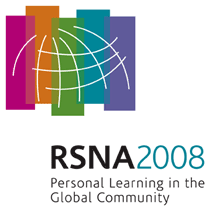
Abstract Archives of the RSNA, 2008
SSC13-06
Additional Value of Diffusion-weighted MRI to Conventional MRI for Predicting Treatment Outcome in Chemo-radiotherapy (CRT) of Head and Neck Squamous Cell Carcinoma: Preliminary Results
Scientific Papers
Presented on December 1, 2008
Presented as part of SSC13: ISP: Neuroradiology/Head and Neck (Tumors and Lymph Nodes)
Vincent Vandecaveye MD, Presenter: Nothing to Disclose
Piet Dirix MD, Abstract Co-Author: Nothing to Disclose
Frederik De Keyzer MS, Abstract Co-Author: Nothing to Disclose
Vincent Vander Poorten MD,PHD, Abstract Co-Author: Nothing to Disclose
Ilse Roebben BMEDSC, Abstract Co-Author: Nothing to Disclose
Sandra Nuyts MD, Abstract Co-Author: Nothing to Disclose
Robert Hermans MD, PhD, Abstract Co-Author: Nothing to Disclose
et al, Abstract Co-Author: Nothing to Disclose
The purpose was to asses the additional value of diffusion-weighted imaging (DWI) for predicting treatment outcome in chemo-radiotherapy (CRT) of head and neck squamous cell carcinoma (HNSCC).
Thirty-one patients with HNSCC were included. Magnetic resonance imaging (MRI) was performed prior to and 3 weeks after CRT, including T2-weighted and pre- and post-contrast T1-weighted and an echo-planar DWI-sequence with 6 b-values (0 to 1000 sec/mm2). ADC was calculated over the entire range of b-values and evaluated in a blinded fashion compared to the conventional MRI for primary tumors and metastatic lymph nodes (LN) separately.
For correlation of the imaging results, patients were followed for 2 years. Absence of tumor progression during 2 years was considered good treatment response while tumor recurrence was diagnosed by lesion progression and/or histopathology.
Positive and negative predictive value (PPV, NPV) were calculated for the ADC of primary lesions and LN separately, in correlation to treatment outcome. Subsequently, the ADC was compared to conventional MRI per patient to determine the potential additional value for prediction of treatment outcome.
Using a threshold of 0.0016 mm2/sec, the ADC 3 weeks after CRT showed a positive predictive value (PPV) of 85% (11 true (TP) versus 2 false positive (FP)) and a negative predictive value (NPV) of 100% (21 of 21 true negative) for prediction of tumor recurrence for the separate primary tumors.
Using a threshold of 0.0013 mm2/sec, fthe ADC, 3 weeks after CRT showed a PPV of 30% (6TP versus 14FP) and a NPV of 95% (36TN versus 2FN) for prediction of recurrence for the separate metastatic LN. Per patient, DWI correctly altered the conventional MRI-based prediction of treatment outcome in 9 cases at the primary site (5 TN, 4 TP) and in 7 cases in the LN (3 TN, 4TP). DWI erroneously altered the conventional MRI-based prediction to potential tumor recurrence in 7 patients, in 6 cases for LN and 1 at the primary site.
DWI shows potential value, complementing conventional MRI, to predict outcome in CRT of HNSCC, especially in primary tumor sites and for exclusion of persistent nodal disease. Further improvement in spatial resolution and postprocessing is requiered to improve PPV for prediction of nodal recurrence.
The addition of early DWI may help in patient selection for (planned) salvage surgery after CRT for HNSCC.
Vandecaveye, V,
Dirix, P,
De Keyzer, F,
Vander Poorten, V,
Roebben, I,
Nuyts, S,
Hermans, R,
et al, ,
Additional Value of Diffusion-weighted MRI to Conventional MRI for Predicting Treatment Outcome in Chemo-radiotherapy (CRT) of Head and Neck Squamous Cell Carcinoma: Preliminary Results. Radiological Society of North America 2008 Scientific Assembly and Annual Meeting, February 18 - February 20, 2008 ,Chicago IL.
http://archive.rsna.org/2008/6016790.html

